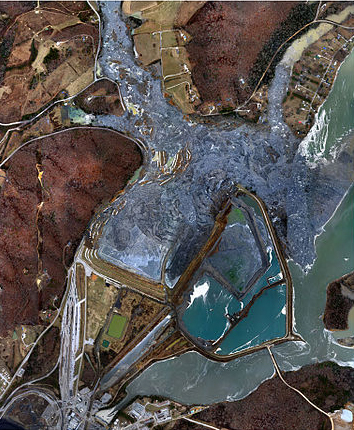Background
 The coal ash spill on December 22, 2008 at the TVA Kingston Fossil Plant in Roane County, TN poses potential health risks to a wide variety of fish and wildlife. A dike from a coal fly ash slurry pond failed releasing approximately 5.4 million cubic yards of coal ash into the nearby Emory, Clinch and Tennessee Rivers and covering approximately 300 acres of land. Coal ash contains elevated concentrations of a variety of trace elements including As, Cd, Se, Sr and V. The immediate physical disturbance was obvious, but the potential long-term ecological consequences of this spill remain a concern. Thus, a site-specific assessment of these effects, or lack thereof, is critical for understanding the consequences of the spill.
The coal ash spill on December 22, 2008 at the TVA Kingston Fossil Plant in Roane County, TN poses potential health risks to a wide variety of fish and wildlife. A dike from a coal fly ash slurry pond failed releasing approximately 5.4 million cubic yards of coal ash into the nearby Emory, Clinch and Tennessee Rivers and covering approximately 300 acres of land. Coal ash contains elevated concentrations of a variety of trace elements including As, Cd, Se, Sr and V. The immediate physical disturbance was obvious, but the potential long-term ecological consequences of this spill remain a concern. Thus, a site-specific assessment of these effects, or lack thereof, is critical for understanding the consequences of the spill.
This project is examining the effects of the spill on both aquatic (turtles) and terrestrial (tree swallows) consumers. We are studying the additive and/or interactive (synergistic and antagonistic) impacts that complex mixtures of contaminants have on exposed wildlife.
 This research is directly applicable to both ecological and human risk assessments along the Emory River because the project will determine 1) whether reproductive injury exists in turtles and tree swallows, and what tissue trace element concentrations provoke these injuries and 2) whether tissue concentrations in animal tissues exceed those known to adversely affect human consumers.
This research is directly applicable to both ecological and human risk assessments along the Emory River because the project will determine 1) whether reproductive injury exists in turtles and tree swallows, and what tissue trace element concentrations provoke these injuries and 2) whether tissue concentrations in animal tissues exceed those known to adversely affect human consumers.
One objective of this project is to identify the spatial extent of trace element exposure in turtles and tree swallows, providing the basis for practical management solutions and risk assessments if deemed necessary. This research project is scheduled to occur over three years, with the first field research season initiated in March 2011.
For more information on the Kingston, TN coal ash spill visit the TVA website.

